If you came across one of the many gorgeous black birds with blue heads and wondered what type of bird it is, you’re not alone. When I began being obsessed with birding, I found myself googling every bird that crosses my path.
This post could help you identify some of the common blue-headed black birds.
10 Pretty Black Birds with Blue Heads
Of course, there are more than 10 birds with all shades of blue heads, but these are my favorites:
1. Brewer’s blackbird (Euphagus Cyanocephalus)
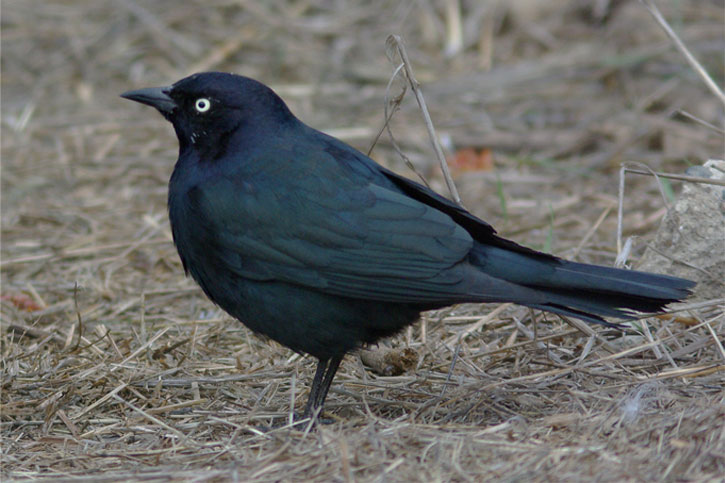
- Length: 8 to 10.3 inches
- Weight: 2.3 ounces
- Wingspan: 15.5 inches
Brewer’s blackbirds are medium-sized birds from the New World blackbird family. They were named after ornithologist Thomas Mayo Brewer.
Brewer’s blackbird are social birds and are known to flock in colonies of up to 100 birds. Most of them migrate to the south for winter, but a few fly west.
- Where are Brewer’s blackbirds found: One of the most common birds in central and western North America, these birds love foraging in the open, such as parks, sidewalks, and even parking ots.
- What do Brewer’s blackbirds look like: Male birds have glossy black bodies with purple or blue head. The color of their heads actually vary depending on where they are located. Meanwhile, female Brewer’s blackbirds are dark brown with black highlights.
- What do Brewer’s blackbirds eat: They primarily feed on seeds and berries, but may also eat insects.
2. Common Grackle
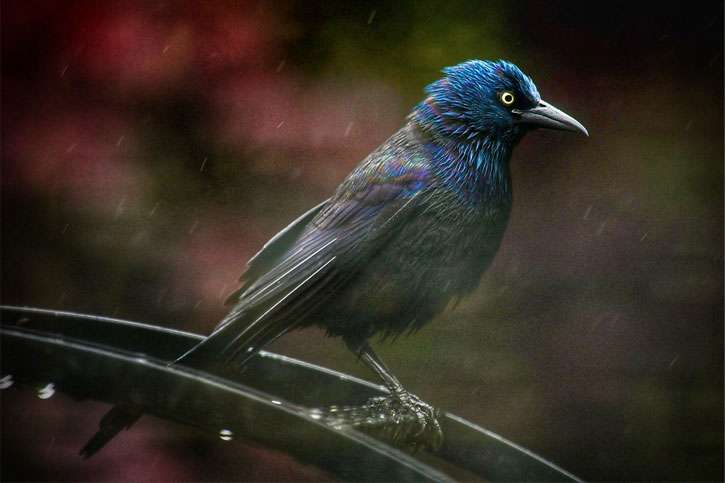
- Length: 11 to 13 inches
- Weight: 2.6 to 5.0 ounces
- Wingspan: 14 to 18 inches
The Common Grackle look similar to starlings, crows and Brewer’s blackbirds. It doesn’t help identifying them since common grackles love to flock with fellow black birds. The only clue that pinpoints Common Grackles are the length of their tails. They’re also the tallest among these group of black bird species.
Common Grackles prefer nesting in small colonies, but they migrate with flocks of other noisy groups that gather in high trees during winter.
- Where are Common Grackles found: Common Grackles, as their name suggest, are pretty commonly found in parks, open woodland, suburbs, agricultural fields, and dense forests with a water source nearby.
- What do Common Grackles look like: These birds have black plumage, iridescent bodies and hues of blue heads. The bills of Common Grackles are distinctly tapered.
- What do Common Grackles eat: As smart foragers, Common Grackles have a varied diet, from fish to mice, grasshoppers, caterpillars, spiders, turtles, worms, crayfish and even adult birds.
3. Shiny Cowbird (Molothrus bonariensis)
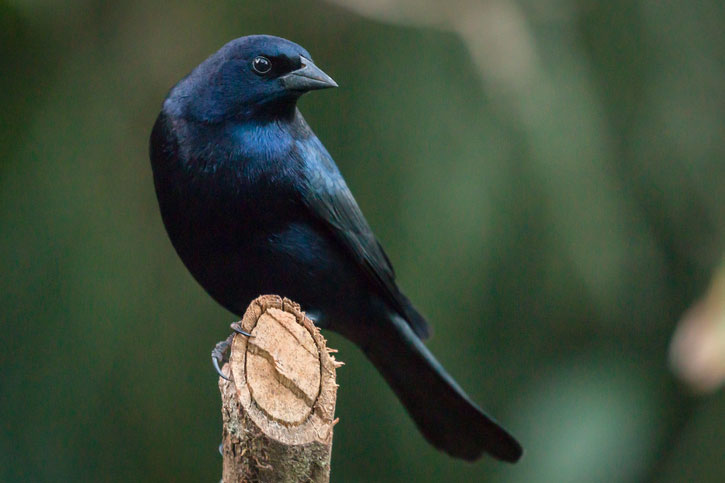
- Length: 7.5 inches
- Weight: 1 to 1.4 ounces
- Wingspan: 11 inches
Like many birds on this list, the Shiny Cowbirds (male ones) have glossy black “head-to-toe” plumage while the females come in brown, tan and black.
Shiny Cowbirds forage in flocks, but they’re not birds with the best personalities. Not only do males act very aggressive with other birds, they’re also known as brood parasites (laying eggs in another birds’ nest).
- Where are Shiny cowbirds found: Native to South America, these Shiny Cowbirds are common in he Caribbean, South America and Southern Florida, usually in open grassy areas and places with livestock.
- What do Shiny cowbirds look like: These medium-sized birds have a rich, glossy purplish, bluish black plumage with bluegreen wings and tails. They have pointy blackish bill and beady black eyes.
- What do Shiny cowbirds eat: Shiny Cowbirds are omnivores and feed mostly on insects, but they also eat seeds as well.
4. The Purple Martin (Progne Subis)
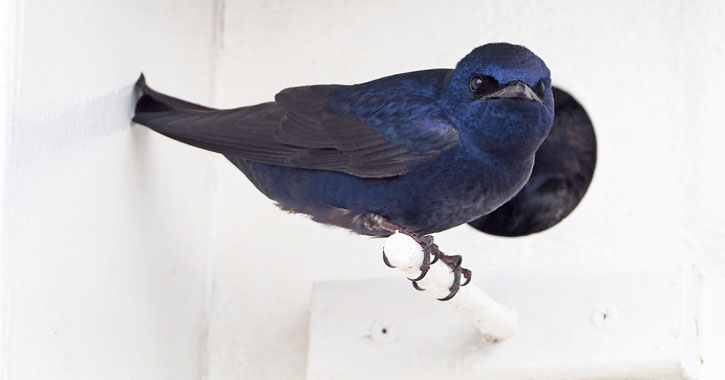
- Length: 7 to 9 inches
- Weight: 2 ounces
- Wingspan: 15 to 16 inches
One of my favorite birds is the Purple Martin. These North American native birds are such a treat to be around. They make their presence known all summer chirping in your backyards.
Purple Martins are the largest member of the swallow family. They’re also known for their speed, unique gliding flight, and numerous voice/calls/songs.
- Where are Purple Martins found: Purple Martins are found all over Mexico, Central America, and North America, more specifically between Texas and Florida.
- What do Purple Martins look like: These medium-sized birds have blackish-blue feathers with iridescent sheen, brownish black wings and tails, long tapered wings, and slightly hooked bills.
- What do Purple Martins eat: These dark-colored birds feed on a range of flying insects, such as dragonflies, bees, winged ants, and other bugs. Whenever possible, Purple Martins could skim waterways and scoop up small fish or other food from the water using their bills.
5. Blue-necked tanager (Stilpnia cyanicollis)
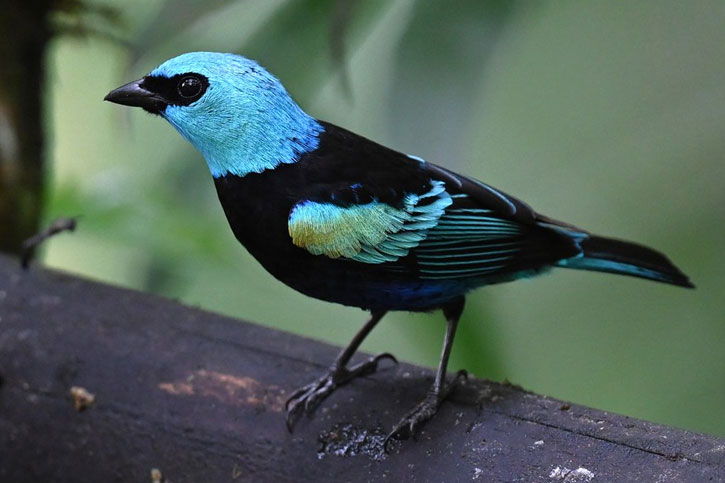
- Length: Around 5 inches
- Weight: 0.5 ounces
- Wingspan: 8 to 9 inches
Blue-necked tanagers are somewhat endangered, since they’ve been targeted by illegal exporters trying to bring these birds to the United States.
Blue-necked tanagers social well with other small birds like finches and softbills, usually flying in pairs or small groups without trouble.
- Where are Blue-necked tanagers found: These birds are native to South America (Brazil, Peru, Colombia, Ecuador, Venezuela), usually found in the tropical lowland forests.
- What do Blue-necked tanagers look like: These small birds are striking for its black back, and a mix of turquoise and sky blue streaks on their heads and wings. Their feet, legs, beaks and eyes are all pitch-black.
- What do Blue-necked tanagers eat: These exotic birds like to eat berries, fruits and flower buds, but they’re sometimes hunt for insects while flying as well.
6. Purple Sunbird (Cinnyris asiaticus)

- Length: Up to 4 inches
- Weight: 0.2 to 1.5 ounces
- Wingspan: 6 to 7 inches
The purple sunbirds are a beautiful, small-sized bird within the sunbird family. They are non-migratory bird species.
Purple sunbirds are not shy. They sing loud and proud, even their chewing and rattling are heard when they’re present in the backyard.
- Where are Purple Sunbirds found: These birds are common in the forests of South and Southeast Asia, but can be also found in the Arabian Peninsula.
- What do Purple Sunbirds look like: The name “purple” refers to the male’s metallic blue and purple feathers with a hint of maroon plumage all over their bodies. Females are olive-colored above with yellowish underbody.
- What do Purple Sunbirds eat: Like many sunbirds, the purple variety also love feeding on nectar. However, they could occasionally hunt insects as well.
7. The Rook Bird (Corvus frugilegus)
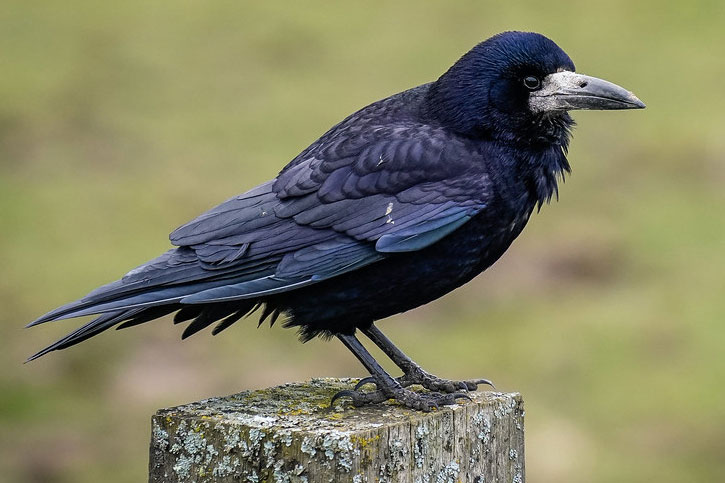
- Length: 17 to 18 inches
- Weight: 9 to 12 ounces
- Wingspan: 36 inches
Rook birds are often mistaken for the more popular raven or crow. Just like their doppelgangers, the rook birds are also smart birds and very common in busy human areas.
Rook birds are social birds that have no problem hanging out with other bird species. They tend to form large flocks.
Like crows, Rook birds supposedly “sense” death or rain and have been a subject of superstitions for centuries.
- Where are Rook birds found: These fairly large birds are common sights in farmlands, fields, gardens and the regions of eastern Siberia, Scandinavia, Western Europe, and the United Kingdom.
- What do Rook birds look like: Rook birds are large, black-feathered birds with a matte dark blue and violet sheen on the head, neck and shoulders. They also have contrasting light-gray bills.
- What do Rook birds eat: They love eating invertebrates like worms, carrion and beetles, but also feed on agricultural scraps like grain.
8. Blue-black Grosbeak (Cyanoloxia cyanoides)
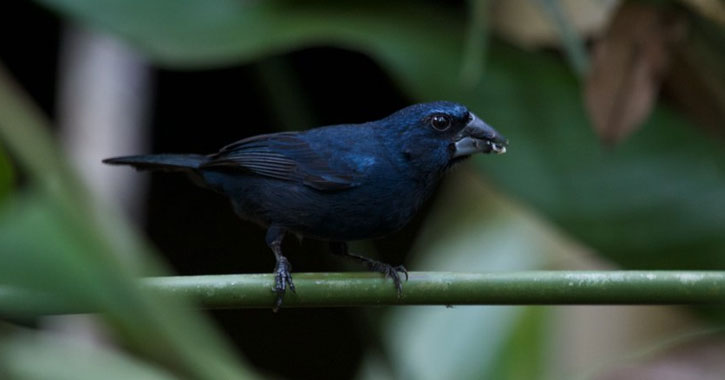
- Length: Around 7 inches
- Weight: 0.5 to 0.8 ounces
- Wingspan: 10 to 12 inches
Blue-black grosbeaks are songbirds. They usually hide from humans, staying mostly near their nests. However, they are identified by their sharp “chit” calls and a mix of whistling and decreasing vocalization for their song.
Like other black birds with blue heads or highlights, the blue color of blue-black grosbeaks comes from the way light strikes their feathers. The “blue” isn’t actually pigment coloration.
- Where are Blue-black grosbeaks found: Native to Central and South America, these birds often hang out in humid dense forests and al lowlands.
- What do Blue-black grosbeaks look like: Male blue-black grosbeaks have dark blue plumage with slightly lighter blue patches on the shoulder, wings and eyebrows. Females have dark brown plumage and hints of red all over their bodies.
- What do Blue-black grosbeaks eat: These birds are omnivores and eat a mix diet of insects, fruits, seeds, snails, ants, caterpillars, and small invertebrates.
9. Black Grouse (Lyrurus tetrix)
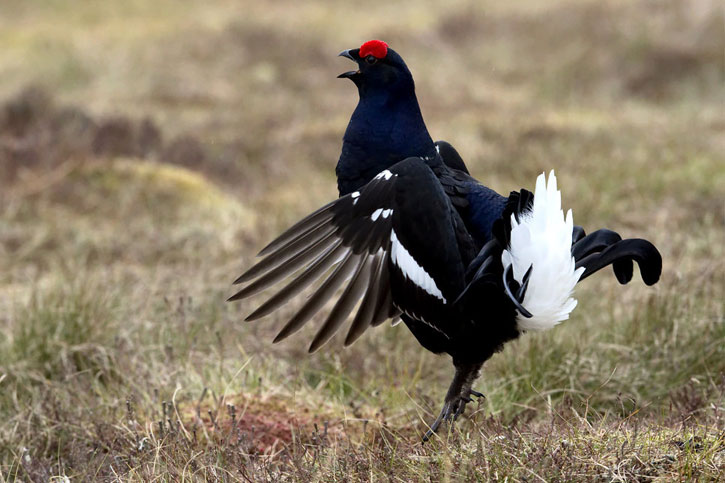
- Length: 15 to 20 inches
- Weight: Around 40 ounces
- Wingspan: 35 to 50 inches
Black grouses looks like elegant chickens in formal wear. They are large sedentary black birds with blue heads. They’re also called “Blackcock,” “Eurasian Black Grouse,” “Northern Black Grouse,” and “Blackgame.”
Female black grouses are brown and look totally different to their male counterparts.
- Where are Black grouses found: Commonly found in Europe, flying in groups and migrating to dense forests.
- What do Black grouses look like: The males have a unique black plumage, dark blue on the head and other parts of the body, and a bright red wattle over the eye. Another distinctive feature of the black grouses is their lyre-shaped tail, which appears forked when flying.
- What do Black grouses eat: These large birds eat insects, berries, seeds, grass, tree buds, flowers, shrubs, and even leaves.
10. Southern Cassowaries (Casuarius casuarius)
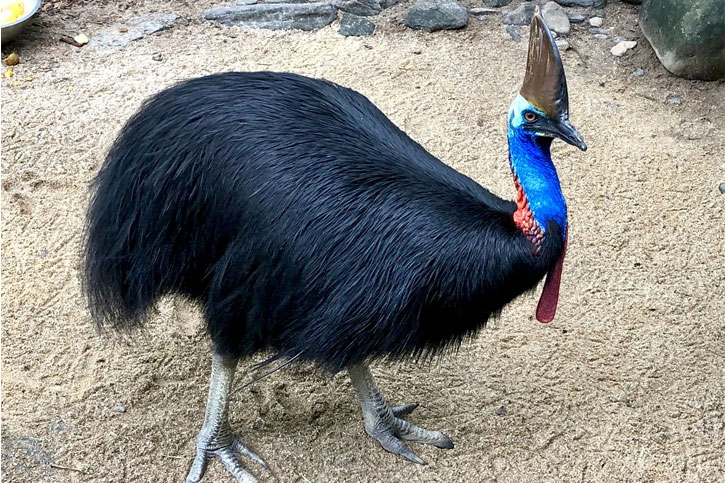
- Length: 70 inches
- Weight: Around 25 ounces
- Wingspan: 59 to 79 inches
Out of all the black birds with blue heads, the Southern Cassowary or “Australian cassowary” is probably the biggest one and come from a group of birds that can’t fly (due to their unique breastbone structures).
There are only three living species of the cassowary – and this is one of them.
Like emus, kiwis, ostriches and other ratites, Southern cassowaries are built with tiny wings disproportioned to their big bodies.
What’s interesting about Southern cassowaries is that males and females look similar with the same colors. The only difference is that females are larger and have more vibrant colors.
- Where are Southern cassowaries found: These birds used to be found mostly all over northern Queensland, but their current isolated populations are reportedly to be in the Wet Tropics and Cape York.
- What do Southern cassowaries look like: These birds are massive and look terrifying with their black feather duster, large round bodies, and thick grey legs. Their blue necks and heads are small, but striking due to the royal blue color and the hard casque that crowns their heads.
- What do Southern cassowaries eat: Despite their size, these birds love eating fallen fruit and plants. Sometimes, they feed on carrion, fungi and small verterbrates and invertebrates as well.
Beyond Black Birds with Blue Heads
Are you attracted to a specific color of birds?
If so, you might like to check out my feature on the awesome purple birds of the world, and birds that lay blue eggs.
